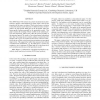Free Online Productivity Tools
i2Speak
i2Symbol
i2OCR
iTex2Img
iWeb2Print
iWeb2Shot
i2Type
iPdf2Split
iPdf2Merge
i2Bopomofo
i2Arabic
i2Style
i2Image
i2PDF
iLatex2Rtf
Sci2ools
ICASSP
2011
IEEE
2011
IEEE
Continuous F0 in the source-excitation generation for HMM-based TTS: Do we need voiced/unvoiced classification?
Most HMM-based TTS systems use a hard voiced/unvoiced classification to produce a discontinuous F0 signal which is used for the generation of the source-excitation. When a mixed source excitation is used, this decision can be based on two different sources of information: the state-specific MSD-prior of the F0 models, and/or the frame-specific features generated by the aperiodicity model. This paper examines the meaning of these variables in the synthesis process, their interaction, and how they affect the perceived quality of the generated speech The results of several perceptual experiments show that when using mixed excitation, subjects consistently prefer samples with very few or no false unvoiced errors, whereas a reduction in the rate of false voiced errors does not produce any perceptual improvement. This suggests that rather than using any form of hard voiced/unvoiced classification, e.g., the MSD-prior, it is better for synthesis to use a continuous F0 signal and rely on ...
Aperiodicity Model | ICASSP 2011 | Mixed Source Excitation | Most HMM-based TTS | Signal Processing |
| Added | 20 Aug 2011 |
| Updated | 20 Aug 2011 |
| Type | Journal |
| Year | 2011 |
| Where | ICASSP |
| Authors | Javier Latorre, Mark J. F. Gales, Sabine Buchholz, Kate Knill, Masatsune Tamura, Yamato Ohtani, Masami Akamine |
Comments (0)

